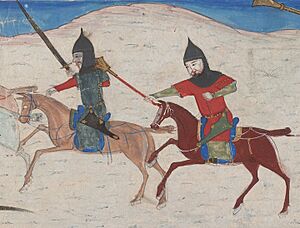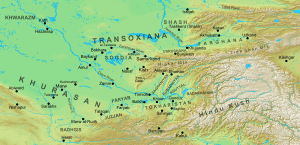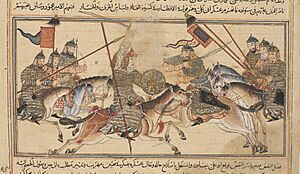Nuh II facts for kids
Quick facts for kids Nuh IIنوح |
|
|---|---|

A picture showing Nuh II stopping a rebellion. From an old book called Majma’ al-tawarikh, made around 1425.
|
|
| Amir of the Samanids | |
| Reign | 13 June 976 – 22 July 997 |
| Predecessor | Mansur I |
| Successor | Mansur II |
| Born | 963 |
| Died | 22 July 997 |
| Issue | Mansur II Abd al-Malik II Isma'il Muntasir |
| Father | Mansur I |
| Religion | Sunni Islam |
Nuh II (Persian: نوح) was a powerful ruler, known as an amir, of the Samanids. He ruled from June 13, 976, to July 22, 997. Nuh II was the son of Mansur I and took over the throne after his father.
Becoming Ruler and Early Challenges

Nuh II became ruler when he was still very young. His mother and his chief advisor, a man named Abu'l-Husain 'Abd-Allah ibn Ahmad 'Utbi, helped him govern.
Around the time Nuh II became ruler, a group called the Karakhanids attacked. They took over the Zarafshan Valley, where the Samanids had important silver mines. In 980, the Karakhanids attacked again and captured Isfijab.
Nuh's advisor, 'Utbi, was worried about Abu'l-Hasan Simjuri. Abu'l-Hasan was the Samanid governor of Khurasan and had become very powerful. 'Utbi managed to remove him from his position in 982. He replaced Abu'l-Hasan with a Turkish general named Tash. Abu'l-Hasan then went to his lands in Kuhistan, south of Herat.
In 982, an army was sent from Khurasan to fight the Buyids, another powerful group. The Samanid forces first did well, but then they were badly defeated. The Buyids were stopped from invading Samanid lands only because their leader, 'Adud al-Daula, died. 'Utbi tried to gather the army again, but he was killed by supporters of Abu'l-Hasan and another general named Fa'iq.
Shifting Power and New Conflicts
After 'Utbi's death, a rebellion started in the capital city of Bukhara. Nuh II had to ask Tash, the governor, for help to stop it. Tash successfully put down the revolt. He then prepared to fight the armies of Abu'l-Hasan, his son Abu 'Ali, and Fa'iq.
However, Tash decided to make peace with them instead. He convinced Nuh II to give Fa'iq control of Balkh and Abu 'Ali control of Herat. Abu'l-Hasan got his position back in Khurasan, and Tash kept his governorship there too.
This peace didn't last long. 'Utbi's replacement, Muhammad ibn 'Uzair, disliked Tash. Because of Muhammad's advice, Nuh II removed Tash from his position and gave the governorship back to Abu'l-Hasan. Tash fled to the Buyids, who helped him. But the Simjuris and Fa'iq defeated Tash in late 987. He then fled to Gurgan and died in 988.
That same year, Nuh II chose Abu Ali Damghani as his new chief advisor. But later, he replaced him with Abu Nasr Ahmad. Six months later, Abu Nasr Ahmad was killed by Nuh's palace guards, called ghulams. So, Abu Ali Damghani was quickly made chief advisor again.
Around this time, Abu'l-Hasan also died. His son, Abu 'Ali, took over as governor of Khurasan. This made Abu 'Ali very powerful, which worried Fa'iq. The two generals started fighting. Abu 'Ali defeated Fa'iq in battle around 990. As Fa'iq retreated, he tried to capture Bukhara. But Nuh's Turkish general, Bektuzun, defeated him again. Fa'iq then went back to Balkh. Nuh II managed to get some of his allies to fight Fa'iq, but Fa'iq still held onto his position.
Battles and the End of Nuh's Rule
The Karakhanids, who had already taken some Samanid lands, launched a full invasion in late 991. Their ruler, Bughra Khan, destroyed an army Nuh II sent to stop him. Nuh II then forgave Fa'iq and made him governor of Samarkand. In return, Fa'iq promised to fight the Karakhanids.
However, Fa'iq later surrendered to Bughra Khan. Bughra Khan then marched towards Bukhara. Nuh II fled, and the Karakhanids entered the capital in the spring of 992. They captured Abu Ali Damghani, Nuh's chief advisor. Nuh II then asked Abu 'Ali, who was in Nishapur, for help. At first, Abu 'Ali refused.
The situation changed when Bughra Khan became sick in Bukhara. He made Nuh's uncle, Abd al-Aziz, the ruler of the Samanid lands, but only as a puppet for the Karakhanids. Bughra Khan then traveled to Samarkand and died on his way north. During this time, Abu Ali Damghani, who was a prisoner of the Karakhanids, also died. Nuh II defeated the Karakhanid soldiers left in Bukhara that summer. He had Abd al-Aziz blinded and put in prison.
Fa'iq tried to take Bukhara for himself but was defeated. He then fled to Abu 'Ali. The two generals settled their past disagreements and decided to end Samanid rule. They started by conquering smaller kingdoms that supported the Samanids. Abu 'Ali invaded Gharchistan and drove out its ruler, Shah Muhammad, and his father.
Nuh II then asked for help from Sebük Tigin of Ghazna. Sebük Tigin agreed, and Nuh's forces also got help from Khwarazm and other allies. A big battle in Khurasan in August 994 resulted in a huge victory for Nuh II and his allies. The rebels fled to Gurgan. Nuh II rewarded Sebük Tigin and his son Mahmud with special titles. He also made Mahmud the governor of Khurasan.
In 995, Abu 'Ali and Fa'iq returned with new armies and forced Mahmud out of Nishapur. Sebük Tigin met up with his son, and together they defeated the rebels near Tus. Abu 'Ali and Fa'iq fled north. Fa'iq sought safety with the Karakhanids.
Nuh II, however, forgave Abu 'Ali and sent him to Khwarazm. The ruler of Khwarazm, who was a Samanid ally, imprisoned Abu 'Ali. Both of them were captured when the Samanid governor of northern Khwarazm invaded. He took over southern Khwarazm and sent Abu 'Ali back to Nuh II. In 996, Nuh II sent Abu 'Ali to Sebük Tigin, and the Ghaznavids later executed him.
Meanwhile, Fa'iq tried to convince Bughra Khan's successor, Nasr Khan, to attack the Samanids. But the Karakhanid ruler instead made peace with Nuh II. Fa'iq was pardoned and given back his governorship of Samarkand.
Even though peace was finally made, the many years of fighting had greatly weakened the Samanids. The Karakhanids controlled much of the northeast. The Ghaznavids had become very strong in Khurasan and the lands south of the Oxus River. The governor of Khwarazm only pretended to obey Nuh's authority.
Nuh II died in 997, leaving the Samanid state in a very weak condition. His son, Mansur II, became the next ruler.


